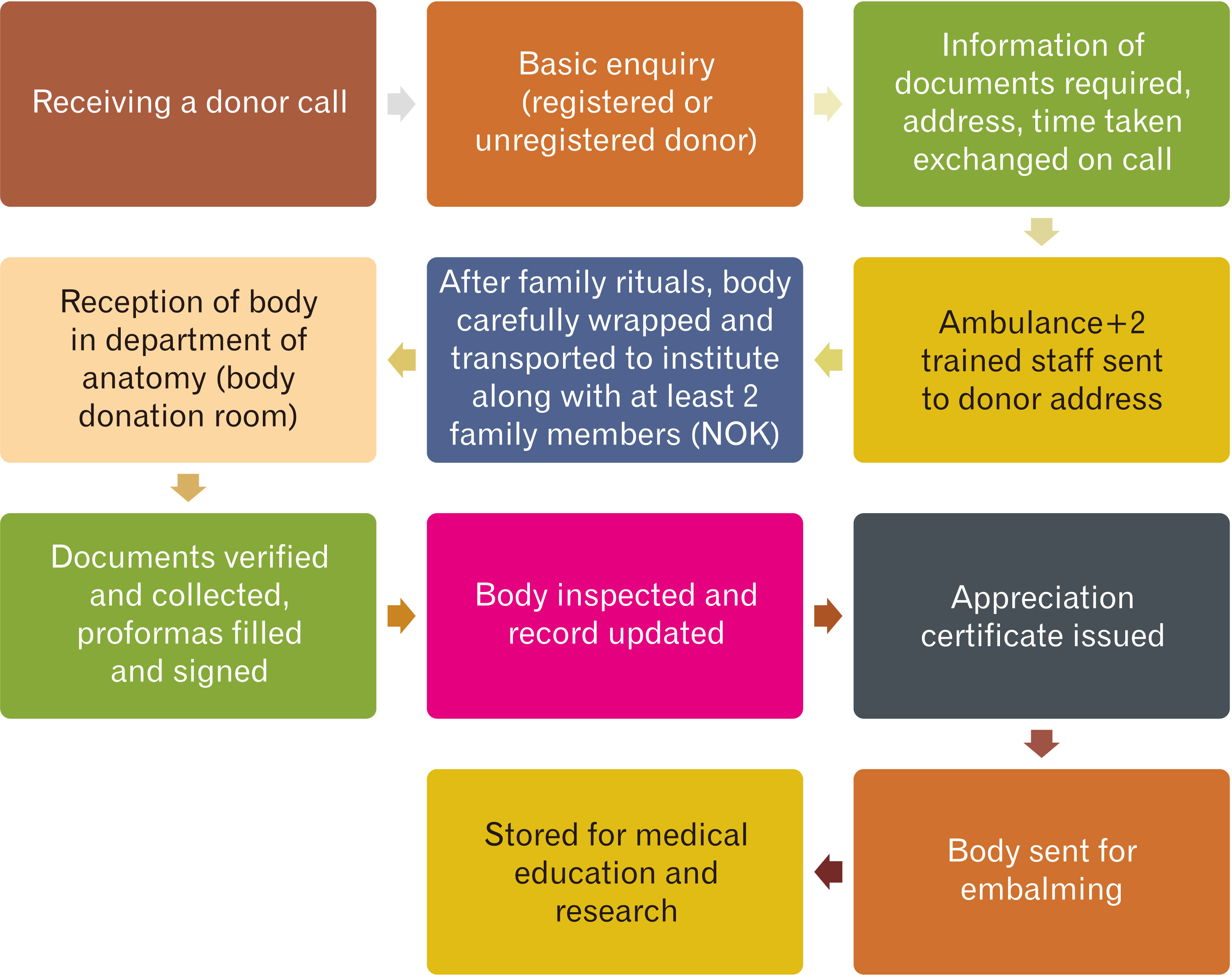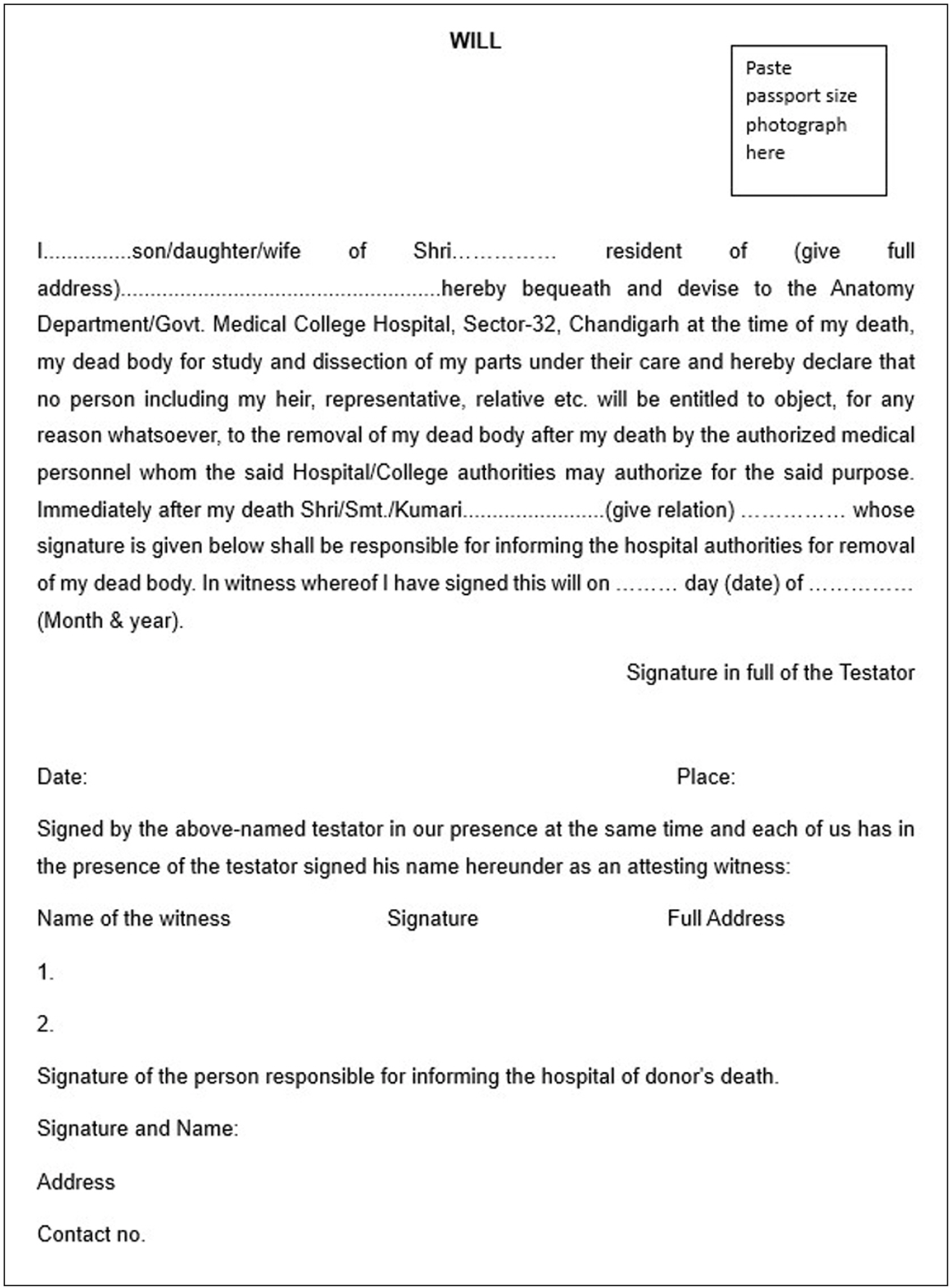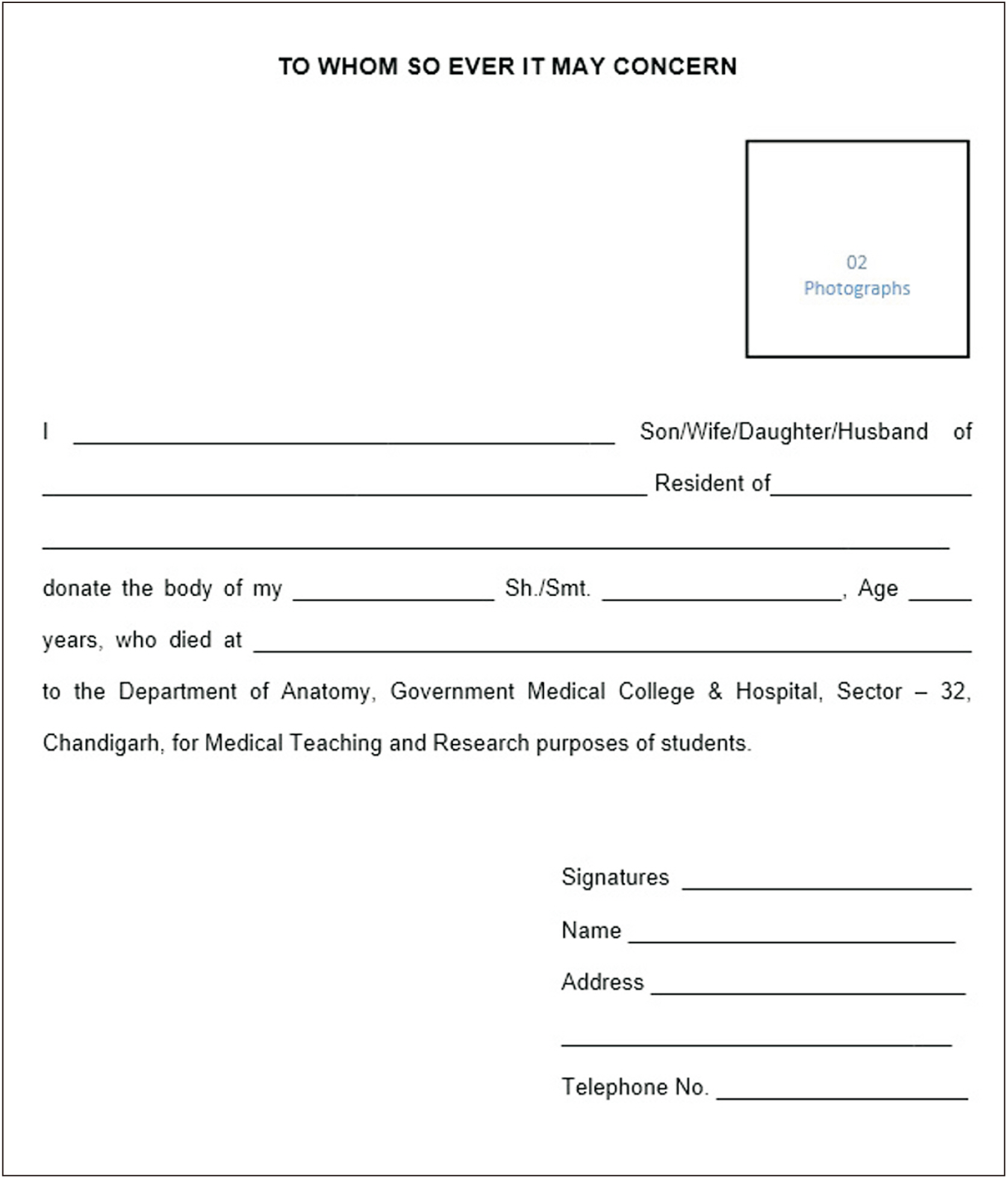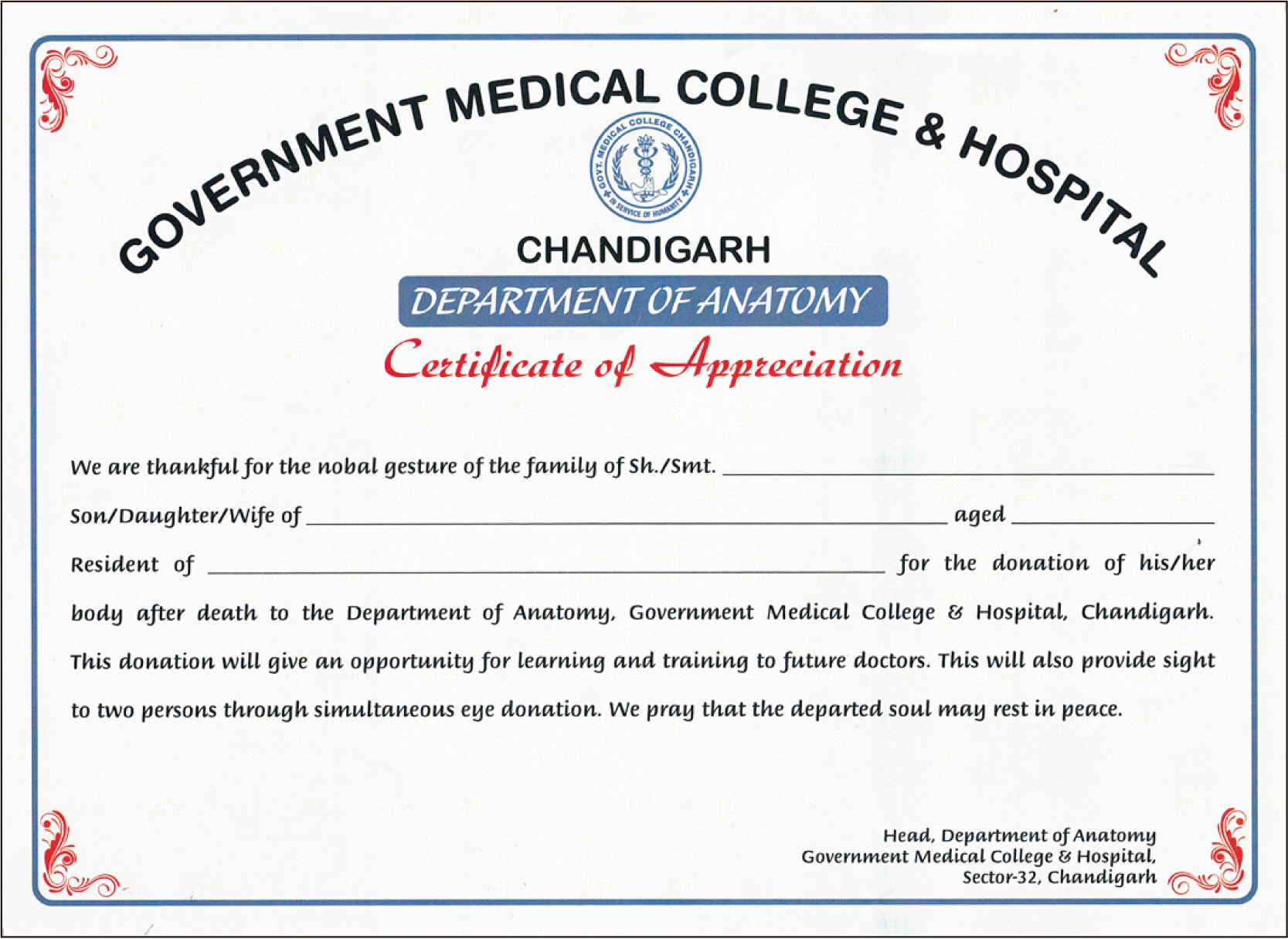Anat Cell Biol.
2024 Jun;57(2):238-245. 10.5115/acb.23.211.
Receiving a donation call to dissection tables: various aspects of whole-body donation in northern union territory region medical college of India
- Affiliations
-
- 1Department of Anatomy, Government Medical College and Hospital, Chandigarh, India
- KMID: 2556568
- DOI: http://doi.org/10.5115/acb.23.211
Abstract
- Body donation is the act of giving one’s body to science for study, practice, and research. This selfless act contributed to the education and training of professionals in the field of medicine. Body donation programs allow medical students to learn about the different aspects of human anatomy, perfect their dissection skills, and develop a better understanding of the relationship between structure and function in the human body. The purpose of article is to improve body donation programs which meet ethical standards and best practices. This article emphasizes the significance of body donation to teaching medical institutions by discussing various aspects of body donation to medical colleges in India and the procedural steps followed, sample proformas and the obstacles faced during the whole process. The process of body donation varies among different countries pertaining to their legal frameworks and the challenges faced. A description of the problems faced in the process of body donation has been discussed with suggestions for potential solutions in this section. The sample formats of the forms filled by donors and the certificates issued by concerned organizations are also provided to clearly understand the process of body donation. The information compiled will pave the way for medical teaching institutions that have yet to start a body donation program.
Keyword
Figure
Reference
-
References
1. Elhadi AM, Kalb S, Perez-Orribo L, Little AS, Spetzler RF, Preul MC. 2012; The journey of discovering skull base anatomy in ancient Egypt and the special influence of Alexandria. Neurosurg Focus. 33:E2. DOI: 10.3171/2012.6.FOCUS12128. PMID: 22853833.
Article2. Riederer BM. 2016; Body donations today and tomorrow: what is best practice and why? Clin Anat. 29:11–8. DOI: 10.1002/ca.22641. PMID: 26475613.
Article3. Bennett RE. Bennett RE, editor. A fate worse than death? Dissection and the criminal corpse. Capital punishment and the criminal corpse in Scotland, 1740-1834. Palgrave Macmillan;2017. p. 159–85. DOI: 10.1002/ca.22641.4. Ghosh SK. 2015; Human cadaveric dissection: a historical account from ancient Greece to the modern era. Anat Cell Biol. 48:153–69. DOI: 10.5115/acb.2015.48.3.153. PMID: 26417475. PMCID: PMC4582158.
Article5. Park HJ, Ahn H, Ki E, Lee JS, Choi Y, Hu KS, Chun YM, Kim HJ. 2021; Body donation trends in Yonsei University: a statistical analysis of donor records. Anat Cell Biol. 54:59–64. DOI: 10.5115/acb.20.261. PMID: 33424016. PMCID: PMC8017449.
Article6. Richardson JD. 2002; Workforce and lifestyle issues in general surgery training and practice. Arch Surg. 137:515–20. DOI: 10.1001/archsurg.137.5.515. PMID: 11982462.
Article7. Bertolo R, Garisto J, Dagenais J, Sagalovich D, Kaouk JH. 2018; Single session of robotic human cadaver training: the immediate impact on urology residents in a teaching hospital. J Laparoendosc Adv Surg Tech A. 28:1157–62. DOI: 10.1089/lap.2018.0109. PMID: 29708828.
Article8. da Rocha AO, Tormes DA, Lehmann N, Schwab RS, Canto RT. 2013; The body donation program at the Federal University of Health Sciences of Porto Alegre: a successful experience in Brazil. Anat Sci Educ. 6:199–204. DOI: 10.1002/ase.1335. PMID: 23184541.
Article9. Hutchinson EF, Kramer B, Billings BK, Brits DM, Pather N. 2020; The law, ethics and body donation: a tale of two bequeathal programs. Anat Sci Educ. 13:512–9. DOI: 10.1002/ase.1922. PMID: 31596033.
Article10. Winkelmann A. 2016; Consent and consensus-ethical perspectives on obtaining bodies for anatomical dissection. Clin Anat. 29:70–7. DOI: 10.1002/ca.22651. PMID: 26475682.
Article11. Habicht JL, Kiessling C, Winkelmann A. 2018; Bodies for anatomy education in medical schools: an overview of the sources of cadavers worldwide. Acad Med. 93:1293–300. DOI: 10.1097/ACM.0000000000002227. PMID: 29561275. PMCID: PMC6112846.
Article13. Rokade SA, Gaikawad AP. 2012; Body donation in India: social awareness, willingness, and associated factors. Anat Sci Educ. 5:83–9. DOI: 10.1002/ase.1263. PMID: 22278885.
Article14. Aneja PS, Bansal S, Sood KS, Saxena A. 2013; Body donation--a dilemma among doctors. J Evol Med Dent Sci. 2:2585–93. DOI: 10.14260/jemds/582.15. Ahmed K, Rowland S, Patel V, Khan RS, Ashrafian H, Davies DC, Darzi A, Athanasiou T, Paraskeva PA. 2010; Is the structure of anatomy curriculum adequate for safe medical practice? Surgeon. 8:318–24. DOI: 10.1016/j.surge.2010.06.005. PMID: 20950770.
Article16. Rokade SA, Bahetee BH. 2013; Body donation in India: a review. Int J Res Med Sci. 1:173–7. DOI: 10.5455/2320-6012.ijrms20130814.
Article17. Kim DH, Shin DH, Hwang YI. 2019; Effects of alternate dissection on anatomy learning. Anat Cell Biol. 52:69–75. DOI: 10.5115/acb.2019.52.1.69. PMID: 30984454. PMCID: PMC6449586.
Article18. Ghosh SK. 2020; The practice of ethics in the context of human dissection: setting standards for future physicians. Ann Anat. 232:151577. DOI: 10.1016/j.aanat.2020.151577. PMID: 32688021. PMCID: PMC7366954.
Article19. Hafferty FW. 1988; Cadaver stories and the emotional socialization of medical students. J Health Soc Behav. 29:344–56. DOI: 10.2307/2136868. PMID: 3253325.
Article20. Agthong S, Wiwanitkit V. 2002; Cadaver donation: a retrospective review at the King Chulalongkorn Memorial Hospital, Bangkok. Southeast Asian J Trop Med Public Health. 33 Suppl 3:166–7. PMID: 12971502.21. Bunprasert T. 1998; The new potential of surgical training: surgical training center. Chulalongkorn Med J. 42:413–5. DOI: 10.56808/2673-060X.3856.
Article22. Christensen AM. 2006; Moral considerations in body donation for scientific research: a unique look at the University of Tennessee's anthropological research facility. Bioethics. 20:136–45. DOI: 10.1111/j.1467-8519.2006.00487.x. PMID: 17039632.
Article23. Government of Maharashtra. 1949. Bombay Act No. XI of 1949. The Maharashtra Anatomy Act (as modified up to the 13th January 2014) [Internet]. Government of Maharashtra;Available from: https://bombayhighcourt.nic.in/libweb/acts/1949.11.pdf. cited 2023 Apr 19.24. Bharambe V, Puranam V, Manvikar PR, Bajpayee P. 2019; Anatomy acts in India: a review. Eur J Anat. 23:469–77.25. Gulielmi IV. 1832. Regis. The Anatomy Act 1832 [Internet]. The National Archives;Available from: https://www.nationalarchives.gov.uk/education/resources/body-snatchers/source-four-the-anatomy-act-1832/. cited 2023 Apr 19.26. Saha A, Sarkar A, Mandal S. 2015; Body donation after death: the mental setup of educated people. J Clin Diagn Res. 9:AC05–9. DOI: 10.7860/JCDR/2015/12246.6011. PMID: 26266106. PMCID: PMC4525495.
Article27. Comer AR. 2022; The evolving ethics of anatomy: dissecting an unethical past in order to prepare for a future of ethical anatomical practice. Anat Rec (Hoboken). 305:818–26. DOI: 10.1002/ar.24868. PMID: 35244981.
Article28. Viljoen JK, Stephens S. 2021; Assessing the perceptions of individuals with differing levels and backgrounds of education towards whole-body donation. Ann Anat. 233:151604. DOI: 10.1016/j.aanat.2020.151604. PMID: 32979528.
Article29. Sasi A, Hegde R, Dayal S, Vaz M. 2020; 'Life after death - the dead shall teach the living': a qualitative study on the motivations and expectations of body donors, their families, and religious scholars in the South Indian city of Bangalore. Asian Bioeth Rev. 12:149–72. DOI: 10.1007/s41649-020-00117-3. PMID: 33717335. PMCID: PMC7747233.
Article30. Dluzen DE, Brammer CM, Bernard JC, Keyser ML. 1996; Survey of cadaveric donors to a body donation program: 1978-1993. Clin Anat. 9:183–92. DOI: 10.1002/(SICI)1098-2353(1996)9:3<183::AID-CA10>3.0.CO;2-N. PMID: 8740481.
Article31. Gunderman RB. 2008; Giving ourselves: the ethics of anatomical donation. Anat Sci Educ. 1:217–9. DOI: 10.1002/ase.39. PMID: 19177414.
Article32. Jones DG. Sisu AM, editor. Human anatomy: a review of the science, ethics and culture of a discipline in transition. Human anatomy - reviews and medical advances. IntechOpen;2017. DOI: 10.5772/intechopen.68524.33. Lauri MA. 2006; Attitudes towards organ donation in Malta in the last decade. Malta Med J. 18:25–9.34. Federative International Committee for Ethics in the Medical Humanities. 2012. Recommendations of good practice for the donation and study of human bodies and tissues for anatomical examination [Internet]. International Federation of Associations of Anatomists;Available from: https://ifaa.net/wp-content/uploads/2017/09/IFAA-guidelines-220811.pdf. cited 2023 Apr 19.35. Ballala K, Shetty A, Malpe SB. 2011; Knowledge, attitude, and practices regarding whole body donation among medical professionals in a hospital in India. Anat Sci Educ. 4:142–50. DOI: 10.1002/ase.220. PMID: 21548060.
Article36. Boulware LE, Ratner LE, Sosa JA, Cooper LA, LaVeist TA, Powe NR. 2002; Determinants of willingness to donate living related and cadaveric organs: identifying opportunities for intervention. Transplantation. 73:1683–91. DOI: 10.1097/00007890-200205270-00029. PMID: 12042662.
Article37. Appaji AC, Kulkarni R. 2012; A survey on the role and the status of cadavers in medical education: an Indian scenario. J Clin Diagn Res. 6:1132–6.
- Full Text Links
- Actions
-
Cited
- CITED
-
- Close
- Share
- Similar articles
-
- Current Anatomical Cadaver Dissection and the Limitation of the Act of Corpse Dissection and Preservation
- A Study about the Directed blood donation program
- A Phenomenological Study for Bereaved Families Who Experienced Body Donation
- A Study on the Relationship between the Awareness of Blood Program and the Blood Donation Experience
- Human cadaveric dissection: a historical account from ancient Greece to the modern era







